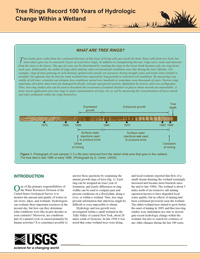 Tree Rings Record 100 Years of Hydrologic Change Within a Wetland
Tree Rings Record 100 Years of Hydrologic Change Within a Wetland
by Thomas M. Yanosky and William M. Kappel
U.S. GEOLOGICAL SURVEY
Fact Sheet 057-97
ABSTRACT
One of the primary responsibilities of
the Water Resources Division of the
United States Geological Survey is to
monitor the amount and quality of waters in
our rivers, lakes, and wetlands. Hydrologists
can evaluate these important resources in the
present day, but how can they determine
what conditions were like in past decades or
even centuries? Moreover, are conditions
part of a natural cycle or caused primarily by
human activities? It is sometimes possible to
answer these questions by examining the
annual growth rings of trees. Each
ring can be assigned an exact year of
formation, and yearly differences in ring
widths can be used to compare past and
present conditions on a flood plain, along a
river, or within a wetland. Thus, tree rings
provide information that otherwise might be
difficult or even impossible to obtain.
Hydrology and tree growth were
investigated within a small wetland in the
Tully Valley of central New York, about 20
miles south of Syracuse. In late 1994 it was
noted that some wetland trees were dying,
and local residents reported that flow of a
small stream draining the wetland seemingly
increased and became more brackish since
the mid to late 1980s. The wetland is about 3
miles north of an extensive salt mining
operation known to have degraded local
water quality, but no effects of mining had
been confirmed previously near the wetland.
The oldest wetland trees started to grow before
the onset of mining in 1889, and thus tree-ring
studies were undertaken not only to investigate
recent hydrologic change within the
wetland, but also to search for evidence of
any other changes during the last 100 years.
Citation: Yanosky, T.M. and Kappel, W.M., 1997,
Tree Rings Record 100 Years of Hydrologic Change Within a Wetland:
U.S. Geological Survey Fact Sheet 057-97, 4 p.
 [Full Report, Acrobat PDF
(104K)]
[Full Report, Acrobat PDF
(104K)]
[an error occurred while processing this directive]
|
